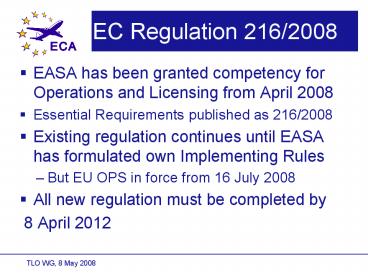EC Regulation 2162008 - PowerPoint PPT Presentation
1 / 12
Title:
EC Regulation 2162008
Description:
Existing regulation continues until EASA has formulated own ... Annex 1 Airworthiness. Annex 2 Applicability. Annex 3 Licensing. Annex 4 Operations. Licensing ... – PowerPoint PPT presentation
Number of Views:66
Avg rating:3.0/5.0
Title: EC Regulation 2162008
1
EC Regulation 216/2008
- EASA has been granted competency for Operations
and Licensing from April 2008 - Essential Requirements published as 216/2008
- Existing regulation continues until EASA has
formulated own Implementing Rules - But EU OPS in force from 16 July 2008
- All new regulation must be completed by
- 8 April 2012
2
EC Regulation 216/2008
- Essential Requirements published
- Annex 1 Airworthiness
- Annex 2 Applicability
- Annex 3 Licensing
- Annex 4 Operations
3
Licensing
- Part FCL with Sub Parts
- A General
- B LPL
- C PPL SPL BPL
- D CPL
- E MPL
- F ATPL
- G IR
- H Type and Class
- I Instructors
- J Examiners
- Part Medical with Sub Parts
- A General
- B Requirements
- C AME
- D General Medical Practitioners
4
New Parts subject to NPA
- Part Authority Requirements with Sub Parts
- A General
- B Ops
- C Licensing
- Part MS with Sub Parts
- A General
- B Ops
- C Training Organisation
- D Aeromedical Centres
5
EASA NPA Timelines
Estimated Timeline for 2008
May
June
July
Aug
Sept
Oct
Dec
Nov
NPA Subject
FCL
?
Authority Req.
?
Management Sys.
?
OPS
?
TLO WG
WG11.09
WG tbd
WG08.05
6
Meeting with EASA
- April 2008 Meeting regarding OPS
- Participants included ECA AEA ASD
- OPS rules need to be based on JAR OPS, with a
familiar structure - Downgrade of status of rules to AMC
- Delay asked for in publishing of OPS NPA, with
EU OPS soon implemented no need to rush - Outcome Patrick Goudou continuing for 5 years
- No delay required
7
Ops Implementation
- EU OPS is considered minimum regulation, EASA OPS
is considered not the minimum but the regulation. - April 2012 deadline set by EU Parliament and this
must drive the implementation timetable. - Complexity and changes are considered not to be a
problem to Operators that will not notice a
change. - Argument is that many JAR Rules currently end
with unless the Authority deems otherwise. This
they feel means that these JAR rules should be
AMC. - Real reason may be that EASA wants power to
change AMC at will without discussion.
8
APEs
- APEs (Advisory Panel of Experts)
- This is envisaged as not being like JAA with
never ending discussion, but more of a feedback
group with no requirement of EASA to follow their
deliberations.
9
EASA AMCs / CS
How to make EASAs legally non-binding
Certification Specifications (CS) / Agreed Means
of Compliance (AMCs) more binding ?
Operator
Proposes / Applies for standard CS / AMC
Proposes to NAA a different CS / AMC
Stakeholder Advisory Panel ?
EASA assessesCS / AMC
If acceptable, EASA publishes CS / AMC
NAA approves
If not acceptable, EASA standard-isation to
stop it
Operator free to use CS/AMC
NPA consultation?
Legalproblem
?
Operator free to use it?
EASA assesses approves for EU-27
or wait for NPA result?
Standardisation visit finding
10
Leisure Pilots Licence
- 4 Categories
- Aeroplane LPL(A) Restricted LPL(A)
- Helicopter LPL(H) Restricted LPL(H)
- Sailplane LPL(G)
- Balloon LPL(B)
11
Size Restrictions
- LPL(A)
- 2000kg or less
- max 3 passengers, never more than 4 POB
- LPL(H)
- 1500kg or less
- max 3 passengers, never more than 4 POB
- LPL(G)
- sailplane, powered sailplane or TMG 850kg or less
- LPL(B)
- Hot air balloons/airships 4,600 m3, Gas 1600 m3
- Max 4 passengers, never more than 5 POB
12
Aeroplane Proposals
- Restricted LPL(A)
- Specific Privileges/Conditions Local flights no
more than 50km from aerodrome of departure,
maximum 1 passenger - Experience 20 hours aeroplane or TMG
- Training 10 hours dual, 4 solo, 3 hours
navigation, skill test - LPL(A)
- Experience 30 hours aeroplane or TMG
- Training 15 hours dual, 6 hours solo, 3 hours
solo X-country including 1 X-country of at least
150km with 1 full stop landing - Upgrade - Restricted LPL(A) to Full LPL(A)
- 10 hours flight instruction including 6 hours
dual - 3 hours solo including 1 X-country of at least
150km with 1 full stop landing































